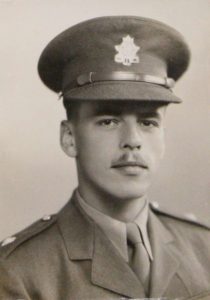
| Rank | 2nd Lieutenant, Captain, Major |
| Unit # | Kent Regiment, Essex Scottish in England |
| Resident | Chatham |

Due to the fact that the major in command of his company met with an accident and could not embark for France Captain Steele was appointed to take over command. He led the company in every attack in which the Essex Scottish had been engaged in and this led to his promotion to the rank of Major.
The CDM 23/09/44 reported that Major Steele was at Antwerp, Belgium
The CDN 6/10/44(P) reported the awarding of the Military Cross for major Steele.
It was reported in the CDN 23/11/44 that Major Steele had been awarded the Military Cross. His citation reads as follows:
“ Capt. (A-Major) Steele, commanded “D” company; The Essex Scottish Regiment on the afternoon of July 29, 1944. The company was given the important task of capturing the orchard and house south of Caen on the Caen-Falise road. While advancing into the attack with company headquarters, number 16 platoon was pinned to the ground by heavy light machine gun fire, and was unable to advance on it’s objective.
Appreciating the gravity of the situation, Major Steele immediately recognizes his company headquarters, and with a total disregard for personal safety, led them through intense light machine gun fire to the company objective. It was then found that an enemy strong point still remained. In spite of the fact that both his personal runner and company headquarters Bren gunner had been killed. Major Steel regrouped his men and led the attack which successfully destroyed the body of enemy impeding the advance of number 16 platoon.
The success of this operation can be largely attributed to the ability, aggressive spirit and courage of this officer.”
Sgt. Hugh Ivison served under Major Steele and in an interview reported in the Chatham Daily News upon his return from overseas gave a glowing account of Major Steeles devotion to duty and an example of his leadership by example
“I was serving under Major Steel when he won his ‘crown’ (insignia of the rank of Major) in the field. I personally know of one action where he was ill enough to go back to hospital, but he went on fighting for three days. He was slightly wounded three times but kept on fighting. It is things like that which inspires men and gives them confidence. I don’t care who knows it , our officers were tops.”
The first indication that Canadian units were in action in the Antwerp area on their way to the Schelde River 30 miles to the west also involved Major Steele. Maurice Desjardins, CP War Correspondent interviewed Major Steele and Major Donald MacKenie of Ingersol.
Major Steel recalled “Our Typhones came over at 18:30 to attack one of the old forts built by the Belgians around Antwerp in the 1880’s.” MacKenzie said. “An hour later dusk fell and a fighting patrol of German infantry came wading across the flooded dykes behind a fierce mortar barrage.”
Steele added the Canadian units had withdrawn for some 200 yards under the weight of the mortar fire until they could call for help of a Canadian artillery force commanded by Major Bill Carr of Toronto. The Canadians eventually won the encounter driving the Germans back.
Outside the headquarters a group of men who had been in action were describing the gallantry of their commanding officer. Wounded severely in both legs during the early stages he had refused to be evacuated and remained in his control room throughout.
The CDN 23/02/45 reported that Mr. and Mrs. Steel received a morning cable that their son Major Telford Steele had been wounded-in-action a second time. The cable contained the usual “the nature of his wound is not yet available, but information will be forwarded as soon as possible”.
This time however, he had been removed to a military hospital for treatment. At the time of his second wounding he was second-of-command of a regiment with which he was serving in the present fighting on the western front.
Major Steele has had a brilliant record in the Army. Anxiety will be felt until the full particulars are received. It was reported in the CDN 24/02/45 Major Steele sent a cable to his parents “Am in hospital. Nothing serious. Feeling fine”.
Good news for his parents, his many friends in the Chatham community that his condition was not alarming
The CDN 29/03/45 reported that His Majesty the King had been decorated for gallantry in action with a “Mentioned in Dispatches”.
Si, wounded in this action, was hospitalized and invalided back to Canada and to be discharged from the Army in 1946.
A photograph of Major Steele receiving his Military Cross from General Montgomery in 1944 is available. JRH.
The CDN 5/11/45(P) reported that Major Telford E. Steele MC. Married Nora May Kidd of New Westminister, BC. The bridesmaid was Lieut. Edith Kidd the sister of the bride and the best man Capt. Emerson Coatsworth formerly with the Kent Regt.
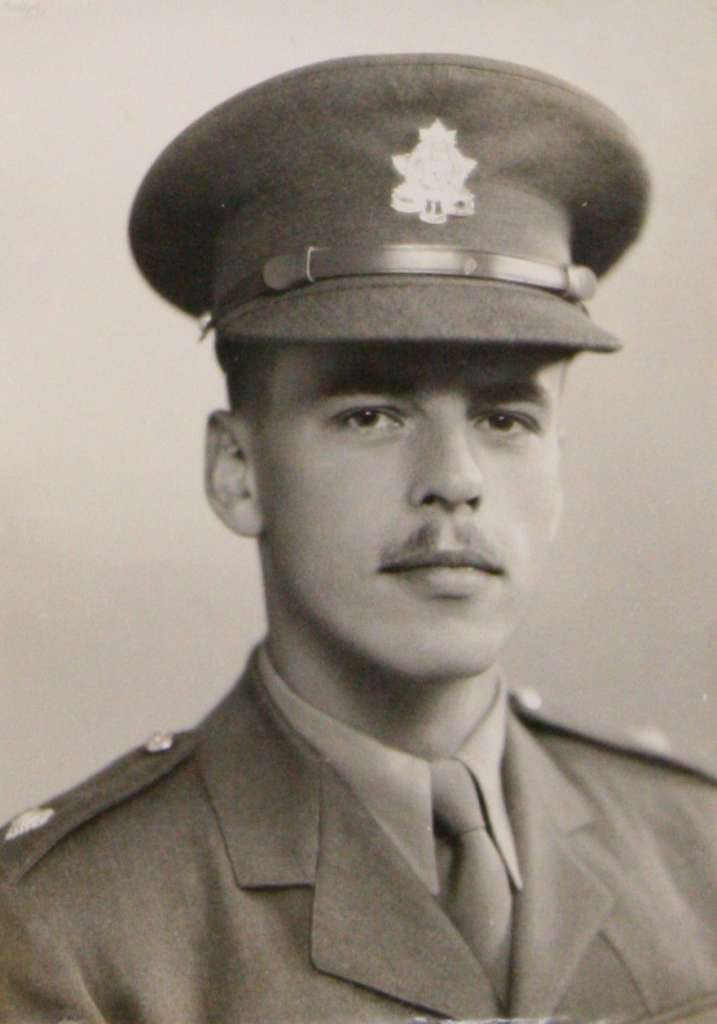
The following is unedited and written by courtesy of Telford (Ted) Steele, Nephew.
Telford Ezra “Si” Steele 1915-2000
The early years
Telford Ezra Steele was born in Fort Erie, Ontario in 1915, the youngest of the three sons. In 1918, the family moved to Chatham, where his father Ezra’s new position to help supervise a fast-growing natural gas industry began.
The photos shown here for the most part have him dressed in very fancy clothes, almost sissified outfits, which may just have been the style of the time. Late Victorian standards were not yet gone, apparently.
Called ’Si’ by his mother and himself, almost all other photos show him wearing a tie.
Keeping in mind that with brothers Ralph being 9 years older and Carl, 4 years older… Si’s childhood may have been a bit more relaxed than his brothers’ upbringing. He seems generally happier with his lot, in most photos.
No records from the schooling of any of the boys, other than some notes on Ralph’s achievements in his studies have been found to date.
Si was athletic, and especially loved hockey. He became a lifelong Boston Bruin fan, which surprises me since their Hall of Fame Line was the Kraut Line! What irony when you look at his middle years! To him, Bobby Orr was the greatest player ever, and he remained his favourite.
In his own words, Si wrote…
“In my teens I was very interested in all sports. I played hockey for CCI and CVS in 1933, 1934 and 1935; in 1935 we won the WOSSA championship, the only Chatham team to ever do this. I also played football for CCI.”
“In the fall of 1935, I started working for the Union Gas Co. in London, transferred to Chatham in 1937, and then to Sarnia in 1938.” – Si Steele
The war years
In 1939, Si decided to join the Kent Regiment. War was looming at the time, and Si was assigned during July 1940 – Sept 1942 at vital security points, guarding Halifax & the West Coast in British Columbia. His abilities and leadership skills brought him several promotions.
The young recruit…
“In June of 1940 I joined the active army as a sergeant and trained the militia troops in Chatham. Then in July of 1940, the Kent Regiment mobilized and I received my commission as an officer (2nd Lieutenant).
By July of 1943, I had been promoted to Captain, and was second in command of “D” Coy. In June of 1944 the regiment landed at Normandy, France.
In July of 1944, I was promoted to Major, and also that month was awarded the Military Cross. I commanded “D” Co. until December of 1944, when I was promoted to second in command of the Essex Scottish Regiment.”
While in England, Si managed to keep in touch with the real world and penned these wonderful letters to his ‘namesake nephew’ (me) back home, postmarked on my first birthday.
The battles…
Some of the fighting in which they were involved was the along the Falaise highway, which was the beginning of pushing the Nazis out of France. A large force of Nazis had been almost completely surrounded in an area called “The Falaise Pocket” also known as the “Falaise Gap”, and although many managed to slip away, the Allied Forces captured much of their supplies and heavy weaponry, as the Nazis began to retreat from France into Belgium. It was during this heavy fighting that Major Si won the Military Cross, the first given since the D-Day landing. The citation accompanying his Military Cross reads…
“In late June of 1944, the Essex Scottish landed at Normandy, and A/Major Steele’s leadership and mettle was put to the test. At different battles, the regiment was embroiled in some of the most intense fighting of the war. At a French village called Ifs, Si led “D” Company into battle, attacking a strongly held German position, where the Essex Scots eventually persevered, but at a heavy cost of 18 officers and 300 men killed, or wounded, or taken prisoner.
In the first major direct combat fight in which the Scottish engaged in early July, 1944, Si’s company was tasked with a deliberate attack on the left flank of the Caen-Falaise road, to capture the orchard and house on Verieres Ridge, as this was impeding the armoured advance. While advancing into the attack, number 16 platoon was bogged down by withering German light machine gun fire.
Appreciating the gravity of the situation, Major Steele reorganized his company headquarters, with total disregard for his personal safety, led them through the intense fire to capture the company objective. He discovered that an enemy strong-point remained, and despite the fact that his bren gunner and other staff had been killed, Major Steele regrouped his men and destroyed the enemy strong point. The success of this operation can be largely attributed to the ability, aggression, spirit and courage of this officer.”
Si was regarded by such peers as Col. Alf Hodges, who had been Si’s second in command of “D” Company as “a fine officer, whose tactics were always sound.”
“Major Steele’s troops appreciated that he was a tough officer who wouldn’t demand of his men anything he was not prepared to do himself.”
There was time between engagements to enjoy the comradeship of the men with whom they fought. Although some of the names in these photos have been forgotten, during those times the unit members would have been close companions, ready to fight and put their lives on the line for each other.
The Nazis were forced, at great cost to the Allies, to retreat towards Belgium and eventually into Holland. At least twice, Si was wounded but refused to go to the field hospital, choosing to remain in the fight. This attitude won him much respect from his men, as he didn’t ask them to do a job he wouldn’t tackle himself.
Several times he was “mentioned in dispatches”, meaning he was singled out for his actions in reports back to headquarters.
Si was in the thick of the battles from June 1944 to February 1945. At one point, they encountered “Goliaths”, remote control tanks or “robot tanks”, as they were called. Several times they fought the elite Nazi SS troops. Nazi resistance was stiffening, and every small advance was difficult. In Belgium, near an old fort at the port of Ostend, a group of 300 Nazis and sympathizers holed up with large food supplies in the fort, and awaited a suicide charge by Major Steele’s troops.
Instead, Si chose to turn the Nazis’ own Bofors anti-airrcaft guns on the fort, and began blasting at the walls. In short order, the Nazi commandant asked for terms of surrender, and Major Si’s answer was “No terms, unconditional surrender or we resume fire”. All quickly surrendered, and Si’s unit then had to protect the prisoners from the village people, who likely wanted to tear them apart.
Once the Nazis surrendered & Major Si’s unit collected prisoners, it was necessary that the fort be checked over for safety & that no booby traps had been set. Major Si had the Nazi commander accompany him through the fort, ensuring that he would also be a casualty of any misfortune. They discovered caches of ammunition, food and wine, but no booby traps were located. Si knew how to avoid taking chances whenever he could.
First person account of battles…
As the Allies continued to drive the Nazis north in Holland, Si remembers the villagers who came out of hiding to welcome them.
“They were so happy to see us, older women would come up to me and throw their arms around me. The guys got quite a charge out of that.” They would barter, trading their canned meat and vegetables to the people who had fresh eggs, potatoes and chickens. They used vacant homes for headquarters, and in one location the farmhouse had a couple of cows, and jellies and fruit.
One Christmas, the troops provided chocolate for the children, a rare treat for them. Another occasion saw a series of dances with lunch provided. In Si’s words again…
“These people didn’t have anything to eat. So we’d put a lot of stuff out – sandwiches and stuff- and they would put it into their purses. We didn’t mind, because we knew they didn’t have anything.”
The main hurdle now known as the Battle of the Scheldt was a series of high points of land, forming islands when the area was flooded, to hinder heavy weapon deployment, & paths of attack were severely limited. “D” Company was given the task of attacking & establishing a foothold on the North Beveland peninsula, & of capturing the causeway (referred to by Si as “that damned causeway”) between Walcheren and the mainland. This causeway (think “bridge”) was… and here I return to Major Si’s words…
“The causeway was 1,000 yards long and about 150 feet wide. It was heavily defended, with high velocity 88s (cannons) aimed down its path. I was lucky when we went in, as Company A and Company B had attacked earlier and had lost 3 officers and several men, while accomplishing nothing. Company A had tried walking along the causeway in waist deep water; I decided we would go right down the center; my men might as well be comfortable. Fog came in, and boy, was it thick! “(That old Steele luck again!)
“We cleared a minefield and cleared the Jerries’ wires and took them prisoner before they knew we were there. Then we set our defenses and stayed there all night. They still didn’t know we were there; one of their officers came riding along on a bike, dressed fit to kill and all perfumed up, going to see some woman. He had all sorts of maps and turned out to be one of our most important prisoners. The maps showed us where all their positions were.
More heavy fighting followed, but British troops and commandos finally captured the goal – Walcheren!”
“After 48 hour passes in Brussels or Paris, we were sent back to an area between Antwerp and Brussels for 6 days, the longest break we had since the fighting started. In February of 1945, we attacked east of the Rhine into Germany.” “That was the biggest power fight I’ve ever seen in my life.”
“I’ve never seen so many tanks, artillery pieces, flamethrowers. Cleve was the most-bombed town I’d ever seen. I went forward with my driver, Pete Markowski; we ran into a nest of machine guns and I got a burst in my leg.”
“At one point, I thought we had actually been taken prisoners, but we had been kicking the heck out of them. They knew it wasn’t going to be long before it was their turn, so they let us alone.” “Pete got me out of there. The day I was wounded, 250 men and 13 officers got it in our gang.”
The story of their advance on the Nazis appeared in the Kent County Family Almanac which included the remarkable rescue of Si by his driver Pete Markowski, after Si was stricken by machine gun fire to his left leg in battle.
End of fighting for Si, but not his struggle to get healthy…
Si was taken back to Allied lines and hospitalized; the war was over for him. He spent the next 22 months in various hospitals, both in England & finally in Canada. Doctors wanted to amputate, but Si rejected the idea totally. When he returned to Chatham, he walked with a cane and a metal brace on his leg; this I personally remember. Eventually he needed neither, and managed quite well. Unfailingly, he gave credit to the officers he had served with, and praised the local regiment as “Canada’s Finest” at every opportunity.
The later years
Major Si, wounded in early 1945 in Germany, was hospitalized in England for some months. He arrived back in Canada on April 20, 1945 and was hospitalized at Christie Hospital in Toronto. Several references say he was hospitalized for a total of 22 months. Even so, he was married in November of 1945, and wedding photos show him standing. His determination is again evident.
The wedding ceremony conducted at Park St. United Church vestry was small, with a close friend from the regiment serving as his best man. Si worked for Union Gas for a while, then began a long career with International Harvester, also in Chatham. Wife Norah had been staying with Si’s parents during the time Si was in hospital, around the Spring of 1945 Her own storytelling of events showed her being anxious to be out of there, and on their own.
Even so, they were seemingly at the house on Stanley Avenue for some time, as pictures show. Si was always very attached to his mother I have been told. Being the youngest played a part in that I am sure. I don’t have photos of Si with Ralph during these times, although Si and Carlton do seem to be on good terms. Our mother, Frances, has said, as did Norah, that the 2 of them were close and neither would have managed well at all without each of their friendship. The toddler in these photos is almost always me (Telford “Ted” W. Steele). I was about 2 when Norah first came, and brother Norm wasn’t born yet. Brothers Jim & Richard were 6 & 8 respectively at this time, while brother Don was 12.
An early memory of mine has Si and Norah in a large frame apartment building (of about 4-6 units) on Selkirk St. near St. Clair St. Their apartment was upstairs. During one visit, I expressed interest in her smoking (always unfiltered Buckinghams), so she gave me a lesson. After showing me how to light it, she gave me one – how cool was that! Then came the coughing and choking, followed by her laugh. That was a summer visit, and I remember no other one to that apartment.
About 1952, I think, they bought their first home in a subdivision being built off Bloomfield Road, called Orchard Heights. We went there once, just before they moved in. The yard was a sea of mud with boards down for a walkway. As far as I know Norah wanted to stay there, but fate decreed otherwise.
In early 1953, both of Si’s parents died, and he inherited the house on Stanley Avenue. Not only were Norah’s memories of it less than joyful, Si insisted that nothing was to be changed. For the next 40 years, very little did change, and it was a sore point with Norah.
I seem to remember that infamous metal dishpan with accompanying wall stain for some years (not sure if I really remember it, or…). Actual remodeling was needed but never happened; making the kitchen bigger would have made Norah very happy, but it remained a work area for 2 at most. I seriously doubt that furniture was replaced or even moved around.
Si also kept the gardens which EC always had done before – growing vegetables of all kinds. It was laid out in a tic-tac-toe pattern of squares with paths around each, very neat and organized. In the winter, Si coached hockey, and always made sure that any Steele in his division was on his team. Norm and I benefited, as he always picked us up for games, and brought us home.
In Spring, we helped with the vegetable gardens. We were the sons he never had, I often think.
I babysat a fair amount, watching cousins Kathleen and Mary Ann, while Si and Norah were regulars at the Armoury for Saturday night social functions. These were likely the only occasions when he did remember and discuss war-time events, while in the company of others of the regiment. He was in demand as a speaker, as clippings from the Chatham Daily News show, in keeping with the public personna that both older brother Ralph and father EC had developed and encouraged.
His speeches praised the Kent soldiers who volunteered to fight, while not stressing his role much at all. The troops who served with him were usually happy to do that themselves!
Like many war veterans, Si rarely spoke of events from the war otherwise.
I spoke with a fellow who was establishing a new “Chatham Hall of Heroes”. H e told me he worked with Si at International Harvester for years. He was greatly surprised when I revealed Si’s military background. It had never been mentioned before!
Si loved his dark rum and coke, and he and Norah enjoyed socializing. I saw him over-imbibe only once, at a party in our basement on Elizabeth Street.
He likely had much encouragement that night, and enjoyed himself. He could not be called a “party animal” at all.
But Norah was a different sort. She was bubbly, outgoing, and the life of the party most of the time. I have a paper which tells of her talents put on display in a belching contest. She was fun and sometimes over the top, which I have no doubt embarrassed Si.
It is often said that MaryAnn got along with Si best, as she was very much (probably too much) like her mother. Kathleen and her father were very much alike, & butted heads over issues at times. Both became teachers – Kathleen in British Columbia, and Mary Ann in North Bay.
Si was gradually slowing down & having mobility problems. He was eventually moved to the Thames River Nursing Home in the mid-90s and likely had a stroke, if not a series of them. I suspect his mother, Jennie, also had suffered strokes. This seems to be one of the few bad things in the Steele genes, the other being prostate cancer.
Before living at the nursing home, the time came for Si & Norah to sell the Stanley Avenue house & move to an apartment on Grand Ave, across from the shopping centre. A front yard auction was held and some wartime items were sold off… a real tragedy. I managed to acquire a few items which were in the mountains of material Norah asked me to take.
They enjoyed apartment living, with each side having its own bedroom & bathroom, with a balcony for evening relaxing. Norah’s good friend Wynn lived in the neighbouring building & they teamed up for shopping & outings.
Mom told me several times that having Norah to confide in helped her deal with our father, Carl; in truth, I think Norah felt the same way. Uncle Si was used to being in command & shared little financial details with her. After his death, she found out that their finances were apparently better than she had feared.
Later Norah moved across town to St Andrews Retirement Residence; her friends began to die off, and macular degeneration took her freedom to travel about. She was “adopted” by our son Martin & wife Melissa Steele. She frequently visited their house on Sundays.
Their kids grew up knowing her well. Also, nephew Richard, besides looking after her personal affairs, visited her in Chatham frequently, & she was a guest at his Horseshoe J Dude Ranch in Iona on many occasions. She loved getting away from her routines and more than once told Richard that he “saved her life” by giving her the chance to enjoy the casual, relaxed time at the dude ranch.
She often commented about how lucky she was to have family members looking after her. Among the things she enjoyed were the horses, dogs and cats of the ranch, the chance to shop at the Dollarama store & enjoying “fine dining” at Wendy’s restaurant.
Full military funeral & obituaries
Si passed away on Saturday, July 8th, 2000 at the nursing home.
Words of tribute and remembrance were given by the Parade Commander, Major Greg T. Childs, CD at the funeral service as part of the full military honours bestowed upon Si. A 21-gun salute & honour guard was presented at the cemetery. Interment followed at Maple Leaf Cemetery.
Si received the first ever Chatham Citizen of the Year Award from Mayor William Erickson. End.
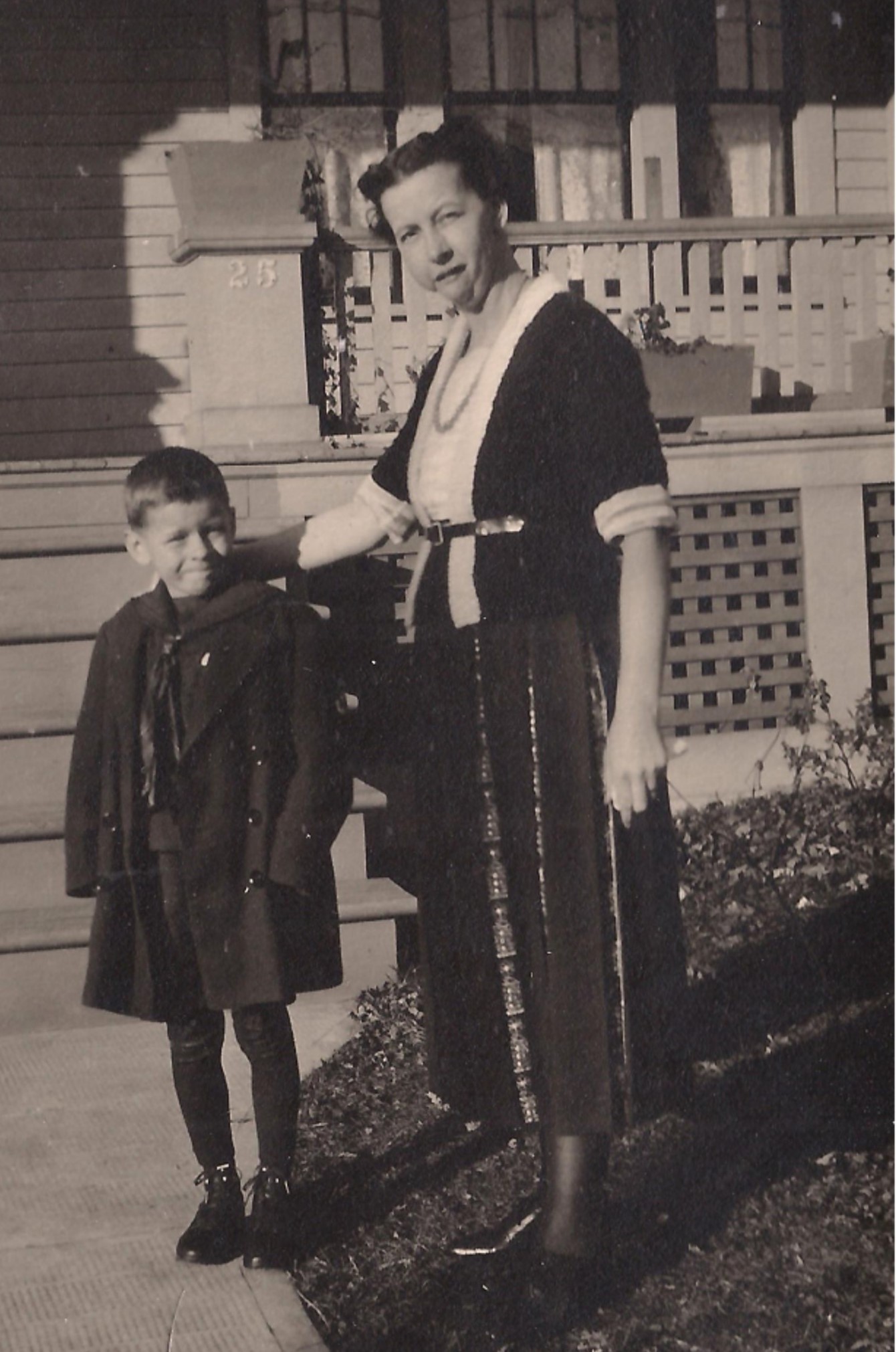
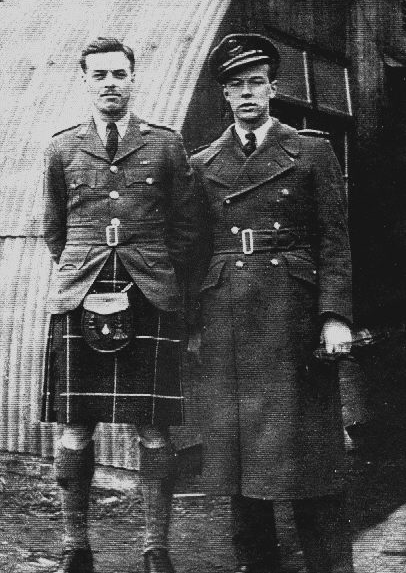
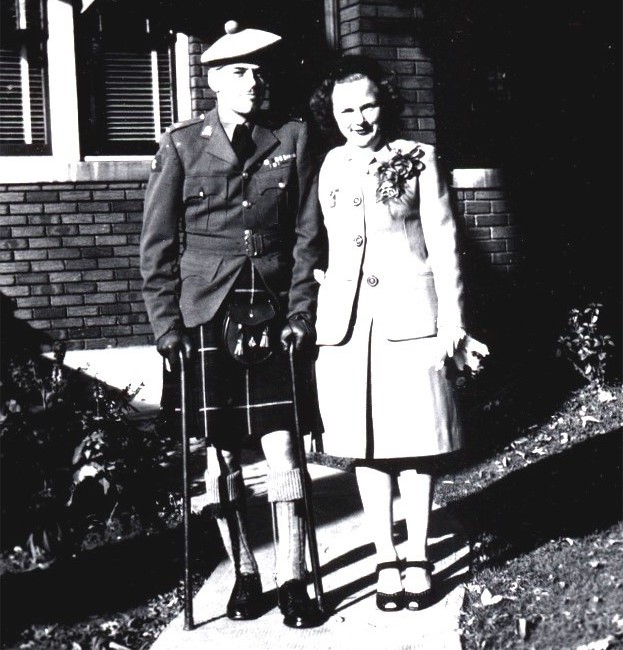
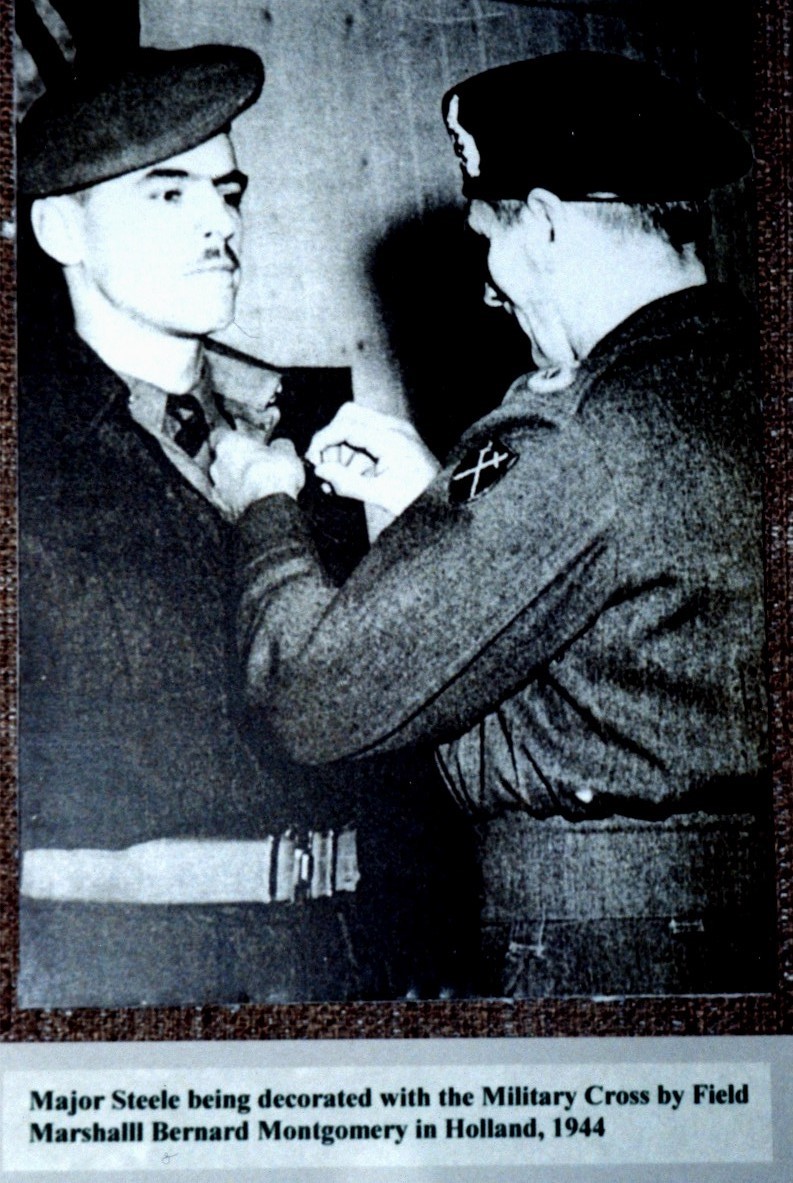
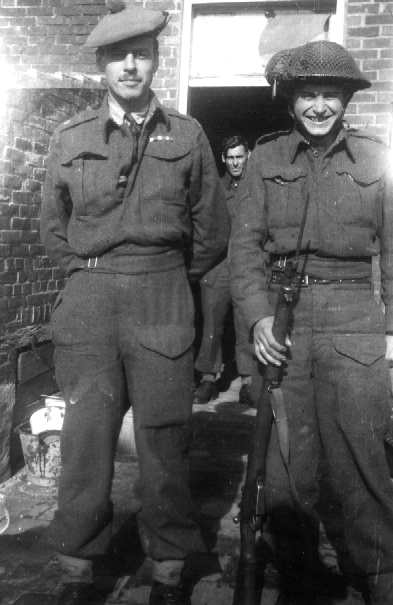
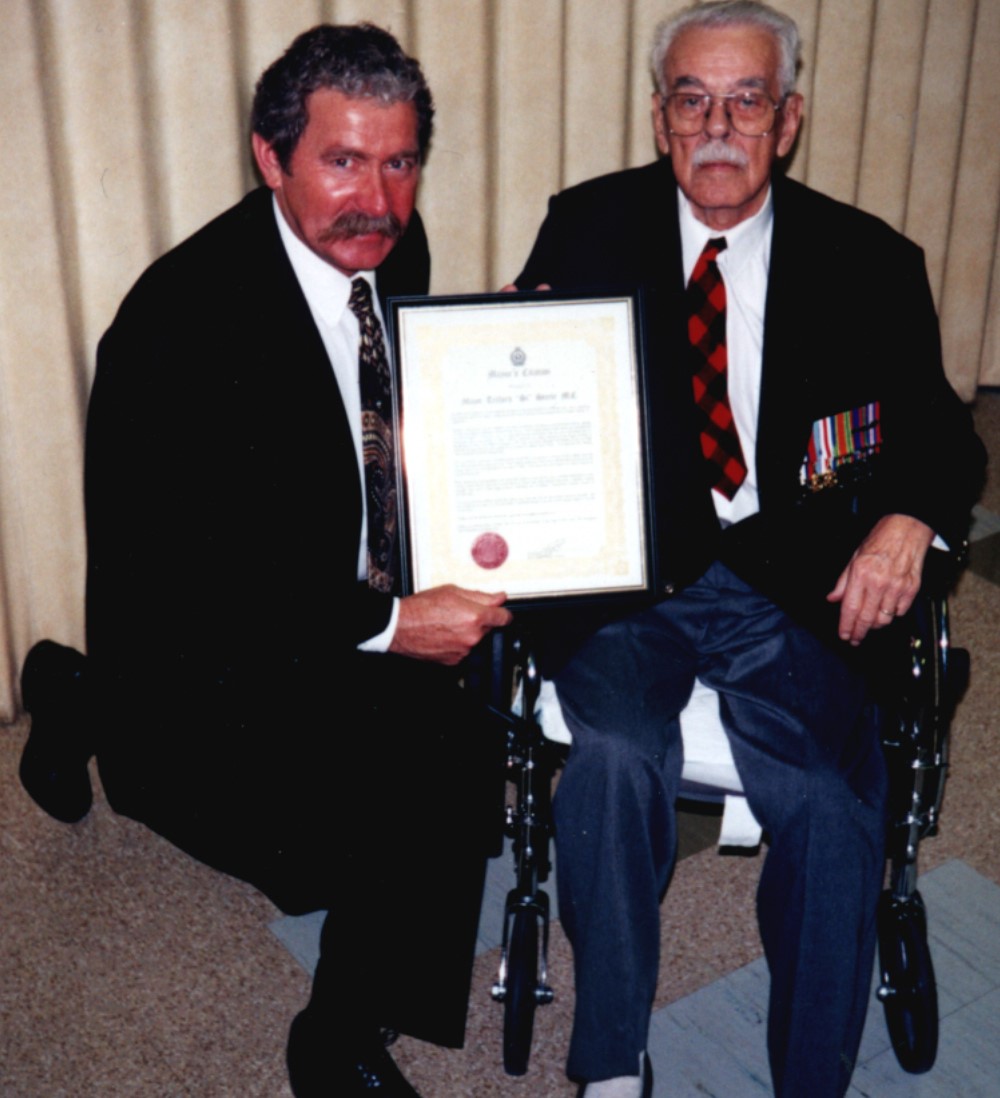
ADDITIONAL INFORMATION
| Awards | Military Cross |
| Sources | CFF-FD44, PSUC-RH, IODE(P), VR, CCI-RH, ATNCB, birthdate correction K. (Steele) Scharf,, KCFA, IODE (P), The Chatham Voice 10/11/16 filed |
| Age | born 1916 |
| Birthplace | Bridgeburg, Ont. |
| Religion | United Church |
| When Enlisted | July 25th 1940 |
| Next of Kin | Ezra Christian Steele (Father) |
Notice something wrong with this record? Or, do you have something to add? Report it using our online form.


